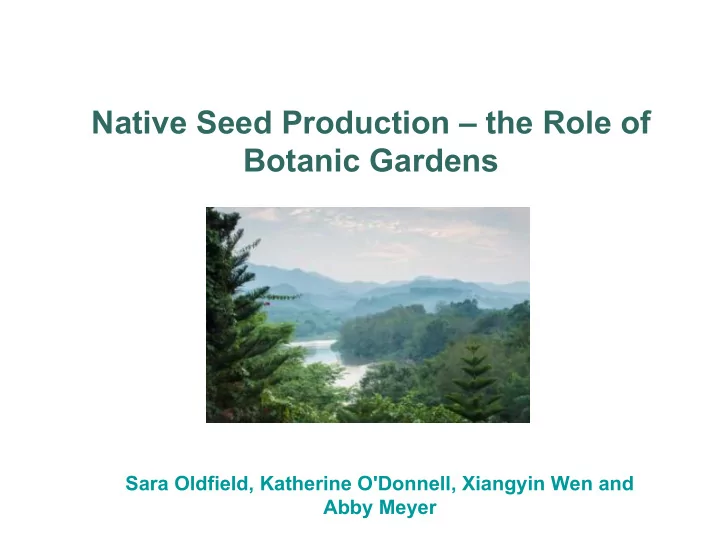

Native Seed Production – the Role of Botanic Gardens Sara Oldfield, Katherine O'Donnell, Xiangyin Wen and Abby Meyer
Botanic Garden Collections Botanic gardens manage at least one-third of the world's flowering plants in their living collections and seed banks, representing a very significant potential resource for ecological restoration.
Seed Banks Currently around 400 botanic gardens have seed banks. Genetically representative collections Long term security Limited space requirement Relatively low–cost.
Location of Seed Banking Institutions
Number of wild taxa banked per country
Conservation Role GSPC Target 8 - At least 75% of threatened plant species in ex situ collections, preferably in the country of origin, and at least 20% available for recovery and restoration programmes 39% of 9496 North American threatened taxa are maintained in germplasm or living collections compared with 40% of 1,918 European species and 37% of 4,404 threatened taxa of China (in 10 major gardens.
Ecological Restoration Role 2010 CBD paper noted that nearly two-thirds of the world’s ecosystems are degraded to some degree Resilient, well connected ecosystems suffer fewer ill effects from climate change than fragmented, overexploited ecosystems Global shortage of appropriate plant materials for ecological restoration – botanic gardens may need to consider increased emphasis on “common” species required to meet restoration needs
Supporting the National Seed Strategy • Botanic gardens can support: • Propagation protocols for “workhorse species” • Partnerships with Federal Agencies & others to supply the restoration plants they need now • Public outreach and political advocacy • As well as rare & threatened species conservation
Colorado Plateau Native Plant Program Partners: • Arboretum at Flagstaff • Desert Botanical Garden, Phoenix
East Coast Restoration North Carolina Botanic Garden: Responsible for collecting in Maryland and Virginia for the current SOS East project. In 2015, 234 collections were made representing 91 species and 75 genera. Training workshops held in 2015 & 2016 Photo credit: SOS/North Carolina Botanical Garden
East Coast Restoration New England Wildflower Society: Responsible for collecting in Maine, New Hampshire, Massachusetts, Rhode Island, and Connecticut for the current SOS East project. In 2015, 254 collections were made representing 91 species and 67 genera. Photo credit:SOS/Mid Atlantic Regional Seed Bank
Global Seed Conservation Challenge Launched by BGCI in 2015. Over 170 gardens are involved https://www.bgci.org/plant-conservation/seedconservation/
Global Seed Conservation Challenge New Training Modules - http://bgci.org/plant-conservation/seed_learning
IUCN SSC Seed Conservation Specialist Group Agreement to establish the Group with BGCI providing the Secretariat was reached at the IUCN World Conservation Congress. Elected co-chairs will work with BGCI to bring together experts in seed conservation from botanic gardens, universities, and the agricultural and forestry sectors.
Ecological Restoration Alliance • Ecological Restoration Alliance of botanic gardens established in 2012 and facilitated by BGCI. • To mobilize botanic gardens, arboreta & seed banks to carry our science-based ecological restoration • MoU with UNESCO Man & Biosphere (MAB) Reserve Programme to train & advise protected area managers
Why botanic gardens? • Emphasize science-based approaches • Well-documented living plant, seed and voucher collections • Generate knowledge of the genetic, physiological, horticultural and ecological characteristics of plants (and their seeds) • Stewards of rare & threatened species • Expertise for teaching, training and outreach • Collaborative – global network (BGCI); regional networks (APGA, CPC); and through Ecological Restoration Alliance of Botanic Gardens (ERA) Hardwick et al. (2011) Conservation Biology 25, 265-275
Supporting Native Plant Production in the UK About 120 native “wild flowers” are currently available with only about 30 spp. sown at quantity Native Seed Hub at RBG Kew’s Millennium Seed Bank is developing a research and development program to support high quality native seed production and habitat restoration.
Supporting Native Plant Production in China • 25,000 plant species in botanic garden collections – 90% native • China's national seed bank - the Germplasm Bank of Wild Species at the Kunming Institute of Botany in Yunnan • 8,855 species in 2015 • 10,000 species by 2020 • No Government Policy requiring native seed for restoration
Supporting Native Plant Production in China Kadoorie Farm and Botanic Garden (KFBG) in Hong Kong is the first to establish a native seed nursery. Every year, more than 25,000 seedlings are grown for its ecological restoration programme.
Supporting Native Plant Production in China Xishuangbanna Tropical Botanical Garden (XTBG) is working with BGCI on the restoration of a tropical forest remnant based on historical records and ex situ plant collections. 67 tree species initially selected. Cultivated in XTBG’s nurseries, over three hundred saplings of 16 native species of local provenance have been planted.
Supporting Native Plant Production in Africa Survey of native tree species held in ex situ collections of botanic gardens and arboreta throughout Africa Promote partnerships between botanic gardens & forest restoration projects & the use of a wider range of indigenous species Active collaboration with botanic gardens in 6 countries
Supporting Native Plant Production in Africa Tooro Botanical Garden
Information, policy & urgent need for more action!
THANK YOU Thank you to BGCI and BLM for use of images
The preceding presentation was delivered at the 2017 National Native Seed Conference Washington, D.C. February 13-16, 2017 This and additional presentations available at http://nativeseed.info
Recommend
More recommend